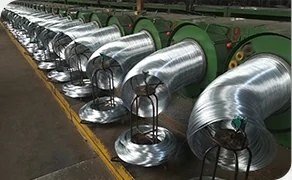 TEL:
+86-13102802206
TEL:
+86-13102802206
 Email:
fencenetting@china.com
Email:
fencenetting@china.com
 Language
Language
 TEL:
+86-13102802206
TEL:
+86-13102802206
 Email:
fencenetting@china.com
Email:
fencenetting@china.com
 Language
Language


The Art of Swaging Stainless Steel Wire
Swaging stainless steel wire is a vital manufacturing process used in various industries to create specific shapes and sizes of metal components. This method involves the deformation of the wire under pressure to achieve a desired profile, enhancing both the mechanical properties of the material and the efficiency of production. In this article, we will explore the swaging process, its benefits, applications, and its significance in modern manufacturing.
What is Swaging?
Swaging is a cold working process that reduces the diameter of a material or shapes it into a particular form through the use of dies. Unlike traditional machining methods, which often remove material to achieve the desired shape, swaging compresses and reshapes the metal without any significant removal of material. This process is particularly suited for stainless steel wire, known for its strength, durability, and corrosion resistance.
The Swaging Process
The swaging process begins with the selection of the appropriate stainless steel wire, which can vary in diameter and grade based on the intended application. Common grades such as 302, 304, and 316 offer different properties that can be tailored to specific needs.
Once the wire is selected, it is fed into a swaging machine equipped with dies that correspond to the desired shape. The machine applies immense pressure, causing the wire to flow into the contours of the die. As the wire is deformed, it becomes stronger due to the work-hardening effect generated by the cold working process. The precise control of pressure, speed, and die geometry ensures that the final product meets stringent specifications for dimensional accuracy and surface finish.
Benefits of Swaging Stainless Steel Wire
Swaging stainless steel wire provides several advantages over other manufacturing methods
1. Material Efficiency Since swaging does not involve material removal, it minimizes waste and allows for more efficient use of raw materials. This is especially significant when dealing with costly stainless steel.
2. Enhanced Properties The work-hardening effect increases the strength of the wire, making it more durable and resistant to wear and fatigue. This can be particularly advantageous in applications where the component will undergo repeated loading.

3. Production Speed Swaging can be performed quickly, allowing for high-volume production. The process can be automated, further enhancing efficiency and reducing labor costs.
4. Versatility Swaging can create a wide variety of shapes and sizes, making it suitable for different applications across multiple industries, from automotive to aerospace and medical devices.
Applications of Swaged Stainless Steel Wire
The applications of swaged stainless steel wire are vast and diverse, reflecting the versatility of the swaging process. Some notable examples include
- Cable and Wire Rope Swaged wire is commonly used in the production of cables and wire ropes, where strength and reliability are critical. These applications range from construction and rigging to high-tension applications in overhead power lines.
- Fasteners Swaged components are used to create fasteners such as bolts, nuts, and pins, which require precise dimensions and enhanced strength.
- Automotive Components In the automotive industry, swaged wire is utilized for various components, including springs, clamps, and brackets, contributing to vehicle reliability and safety.
- Medical Devices The medical field often requires custom swaged wires for devices such as surgical instruments and implants, where biocompatibility and precision are paramount.
Conclusion
Swaging stainless steel wire is a sophisticated process that combines science and engineering to produce high-quality, durable components. Its benefits of material efficiency, enhanced mechanical properties, fast production rates, and versatility make it an invaluable technique in modern manufacturing. As industries continue to evolve and demand more specialized components, the importance of swaging will likely grow, driving innovation and excellence in metalworking. Whether in the production of cables, fasteners, or intricate medical instruments, swaged stainless steel wire is set to remain a critical element in future manufacturing processes.